Moscow Open 2014 Men's Premier Russian Cup
Ajrapetjan, Yuriy - Kokarev, Dmitry
King's Indian Defense
1. d4 Nf6 2. c4 g6 3. Nc3 Bg7 4. e4 d6 5 Nge2 A less common, though not without venom, way of handling the Old Indian Defense. It's possible to later transfer the knight to g3, heading to limit black's kingside play. 5... Nbd7!? It would seem by delaying castling, which will be necessary in any event, black reveals his plans early. We won't rush to conclusions yet though.
[White's idea can be illustrated by the line: 5... O-O 6. Ng3 a6 7. Be2 c6 8. O-O e5 9. d5 cxd5 10. cxd5 b5 11. b4! Nbd7 12. a4!, and holding his opponent on the kingside, white breaks apart the advance on the opposite side of the board Serper -Murrey, North Bay 1997.]
6. Ng3
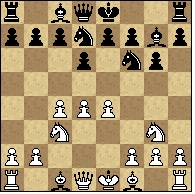
6... h5!? Placing the knight on g3 or b3 (for black accordingly g6 and b6) is frequently like a red flag for a bull to the opposing edge pawns. 7. Be2 e5 8. d5 Qe7 9. Bg5

9...Bh6! So this is blacks idea! Delaying castling allows him to achieve the exchange of dark-squared bishops, profitable with this pawn structure. While observing this game, I recalled my childhood impressions of the match Pazuvaev – Azmaiparashvili, Minsk 1985, in which the Georgian grandmaster carried out an anologous idea in the Classical Variation of the Pirc Defense: 1.d4 d6 2. e4 g6 3. Nf3 Bg7 4. Be2 Nf6 5. Nc3 Bg4 6. O-O Nc6!? (The usual continuation is 6...0-0) 7. Be3 e5 8. dxe5 dxe5 9. Qxd8 Nxd8 10. h3 Bxf3 11. Bxf3 h5! 12. Rad1 Ne6 13. Nd5 Nd7 14. h4 c6 15. Nc3 Bf6 16. g3 g5! 17. hxg5 Bxg5 18. Bxg5 Nxg5 19. Rd3 Nc5 20. Re3 Rd8, and black siezed the initiative. 10. Bxh6 Rxh6 With the center closed the black king is comfortable giving up his kingside castle. 11. Qd2 Rh8 12. h4 a5 Continuing to strengthen the dark squares. 13. Nf1 The knight has nothing to do on g3 and heads to the flexible e3 square. 13... Nc5 14. f3
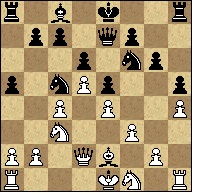
14... Kf8 The pawn walks his way to g7, which allows black to connect his rooks. 15. Ne3 Bd7 16. Qc2 Kg7 17. O-O-O
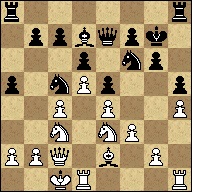
17... Rh7! An excellent prophylactic maneuver. Doubling the rooks on a closed file allows black to nullify his opponent's plan of the g2-g4 advance. In the arising position chances are approximately equal, since the spatial advantes of white is offset by the strong hold black has on the dark squares. 18. Kb1 Rf8 A deceptive, and to a certain extemt, provocative move! Black imitates preparing f7-f5 with Nf6-e8 then f7-f5. 19. g4 The provocation did it's trick – white can't resist taking the bait! 19... hxg4 20. fxg4 Rfh8
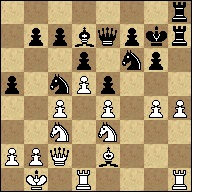
21. h5 The storming white pawn find themselves in the crossfire and continue into the attack! 21... gxh5 22. gxh5 Nxh5 23. Rdg1+ Kf8 24. Bxh5 Rxh5 25. Rxh5 Rxh5 26. Qg2 Qf6 27. Qg8+ Ke7 28. Qb8
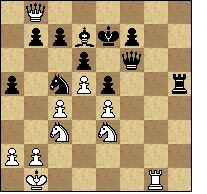
Sacrificing the kingside pawns, the white queen breaks into the opponent's position, but... there's nothing much to attack. 28... Na6 29. Qxb7 Qf2 Begining the decisive counterattack in the soft underbelly of white! 30. Rc1 Nc5 31. Ned1 Qd2 32. Qxc7

32...Rh1.The white pieces are completely bound up, there threatens a decisive knight hop to d3. What follows is brief agony. 33. Nb5 Nxe4 34. Nxd6 Qd3+ 35. Ka1 Rxd1 36. Nf5+ Kf6 37. Qd8+ Kxf5 38. Qxd7+ Kf6 39. Qd8+ Kg7 0-1









